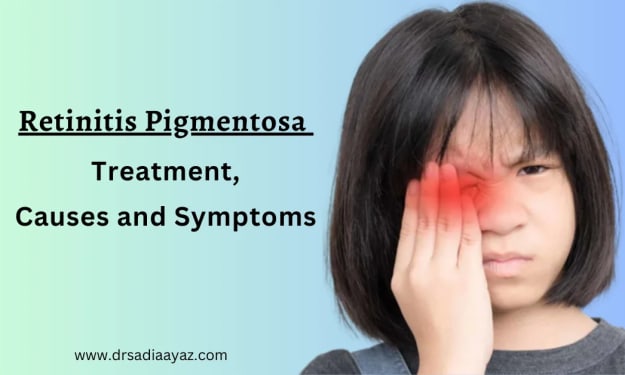Strabismus Treatment Without Surgery | Improve Eye Alignment Naturally
Squint/Strabismus Treatment Without Surgery

Strabismus or squint is a condition in which the eyes are not aligned properly to focus a fine image on the retina. The eye or both eyes can be deviated upwards, downwards, or sideways. It is due to improper coordination between the extraocular muscles of the eye. Some muscles or one muscle can be fibrosed or tight while others might be looser. If the strabismus occurs at an early age, it can lead to reduced depth perception called stereopsis.
Strabismus is not only cosmetically a disfiguring disease but also associated with reduced vision. Timely recognition of strabismus and early strabismus treatment can lead to a better visual outcome.
Early strabismus treatment strategies include strabismus treatment without surgery such as correction of refractive error, patching, and prescribing prisms. While the surgical procedure includes loosening and tightening of the involved muscles called recession and resection respectively. The following points should be kept in mind for strabismus treatment without surgery and with surgery.
Age of the patient at the onset of strabismus
Current age
Overall health status
Patient’s developmental level
Concerns of the patient and/or parents
Symptoms and signs of visual discomfort
Visual demands of the patient
Size and frequency of the strabismus
Presence or absence of amblyopia
Types Of Strabismus:
Strabismus is broadly divided into esotropia and exotropia.
Esotropia: In esotropia, there is the inward deviation of one or both eyes.
Exotropia: In exotropia, there is the outward deviation of one or both eyes.
Both the condition can occur in the near and far distance as well as in any other direction of gaze. Besides these two types, strabismus can have an accommodative element, in which the accommodation supplied by the ciliary muscles is less as compared to the convergence power needed.
In another case, esotropia may result due to a high level of hypermetropia labeled as fully accommodative esotropia. One other type is intermittent exotropia, in which the eye is in an outward direction during visual inattention.
Causes of Strabismus
Strabismus can be caused due to sensory or motor discoordination. In some cases, there is opacity in the cornea or lens which leads to strabismus. There can be muscular disintegration problems, as happens in Duane syndrome and others. Strabismus can also occur as a result of surgery for strabismus, in that case, there will be over or under correction.
Differences in refractive error between the two eyes may result in depression of one eye and resulting in strabismus. It is called stimulus deprivation amblyopia.
Strabismus Complications:
Problems that can occur if the squint is not treated?
Various types of problems may arise due to strabismus. These are
Not an eye muscle problem
Strabismus can not be directly related to a muscle problem. In fact, there is a problem with coordination between the eye and brain. There are few cases in which there can be a direct muscular problem e.g., Duane syndrome and Mobius syndrome.
The cosmetic problems
It is the major concern when strabismus is detected in the initial stages. It can lead to various psychosocial problems as well, especially when a child with strabismus has to face other children in school and other places. The disfiguring appearance will lead to low self-esteem.
The seeing problem
The human eye is normally trained to perceive images from both eyes combine and makeup one fine image. Any condition affecting the normal pathway from eye to brain will lead to suppression of that particular eye leading to strabismus.
Strabismus Diagnosis:
The initial presentation of strabismus is as followed
Headache
Vision problem
Manifest squint
Loss of depth perception
To diagnose strabismus, the health care provider will perform the following examinations to reach the final diagnosis
Visual equity in adults, and retinoscopy in children
Corneal light reflex test
Cover/ uncover test
Complete ophthalmic examination under a slit lamp.
Squint/Strabismus Treatment Without Surgery:
Can squint be corrected without surgery?
1. Optical correction:
The treatment of strabismus starts with optical correction regardless of the cause of strabismus so that binocularity can develop. Full optical correction should be prescribed to patients with hyperopia, anisometropia, and astigmatism. Those patients who find it difficult to adapt to full correction, under correction may be prescribed.
The patients should be evaluated from time to time to make changes in lens prescription as needed.
Bifocals are advised for patients having fusion potential or if full correction at distance can’t be tolerated. Bifocals are often prescribed to patients with esotropia with a high AC/A ratio to reduce strabismus at the near. Convex lenses are also advised for those with more strabismus in near as compared to far distance.
Added minus lens power can be temporarily prescribed in young children for intermittent exotropia that measures the same for distance and near or is larger for distance. According to research, 70 % of patients with intermittent exotropia were managed with concave lens power. Added minus lens power is contraindicated in patients whose exotropia is associated with accommodative insufficiency or who are presbyopic.
If the exotropia remains unchanged with minus lens power the treatment should be stopped. In such cases, multifocal lenses should be used. Patient compliance should be made sure for better management.
Effective Strabismus Treatment Without Surgery | Improve Eye Alignment Naturally in 2023
2. Prisms:
Prisms move the image close to the fovea so that sensory fusion can be maintained. Patients who have fusion and strabismus of less than 20 PD are prescribed prisms. Amblyopia, suppression, or ARC are the contraindications for the use of a prism. In spectacles, maximum power of 10-12 PD can be incorporated. Prisms can also help to reduce the compensatory head posture in strabismus. The patients who are treated with prisms, need to be followed periodically.
3. Optometric Vision therapy:
It is an active procedure in which the patient is trained to improve motor and sensory fusion of the patient in order to avoid amblyopia and improve the range of accommodation. The therapy can be used in association with added lens power, prism, or surgery. Patients with longstanding strabismus can be treated successfully. The time duration is 20-60 minutes per day.
4. Pharmacological therapy:
In past, pharmacological therapy was used to treat strabismus patients with miotics like echothiophate iodide as an alternative to glasses. The drugs reduce accommodation and decrease accommodation convergence effort. The starting dose is usually 0.125% phospholine Iodide (1 drop q.d.), tapered to the desired result.
Eight weeks is the total trial period to check its efficacy The pharmacological agent treatment is less effective than glasses and bifocal lenses, because of local and systemic adverse effects.
The treatment should be reserved for patients with facial deformities or with low compliance or children who frequently break their spectacles. Another drug used is atropine 1 % which dilates the pupil in the non-amblyopic eye. The patient wears spectacles with atropine in the non-amblyopic eye. This therapy forces the patient to forcefully accommodate the amblyopic eye. This therapy is more effective for children with moderate amblyopia.
5. Chemo denervation:
The injection of botulinum toxin type A can be used as an alternative or an adjunct to conventional incisional surgery in selected strabismic patients. In this therapy temporary paralysis of the extraocular muscles leads to a change in eye position This change has been reported to result in long-lasting and permanent alteration in ocular alignment. Usually, one injection is sufficient to produce the desired results.
The side effects of the therapy include ptosis and vertical strabismus Although one injection is often sufficient to produce positive results, one-third to one-half of patients may require additional injections. This technique has been most successfully used in patients with acute abducens nerve palsy and adults with small-angle deviations.
Squint Treatment with Surgery
Eye-Muscle Surgery
The non-surgical treatment should be considered before..... for more details Click Here
About the Creator
sadia ayaz
My name is Dr. Sadia Ayaz and I am an ophthalmologist and eye surgeon. My medical degree is from Pakistan, I have done FCPS-1 / IMM from the College of Physicians and Surgeons Pakistan.
Enjoyed the story? Support the Creator.
Subscribe for free to receive all their stories in your feed. You could also pledge your support or give them a one-off tip, letting them know you appreciate their work.





Comments
There are no comments for this story
Be the first to respond and start the conversation.